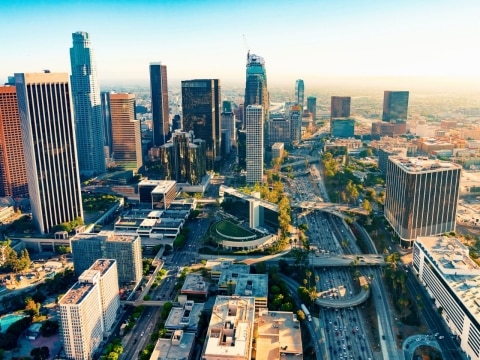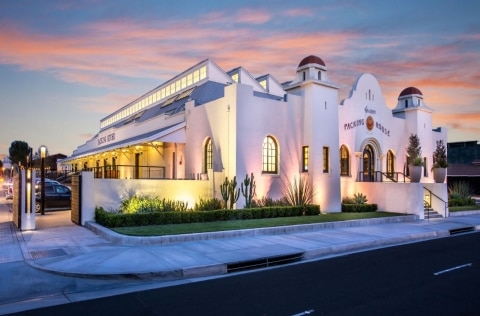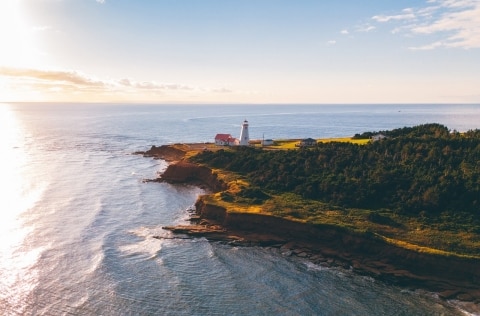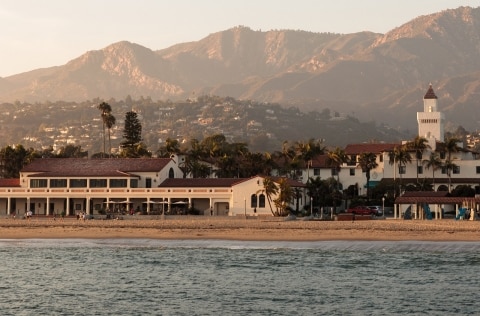45 Awe-inspiring Natural Wonders in America
The United States is filled with beautiful places to explore from ultra-blue ice caves to a park filled with dinosaur fossils and a valley that could pass for Mars. Whether you’re planning the road trip of a lifetime or an immersive getaway in the wilderness, we’ve rounded up the most incredible natural wonders in America to add to your bucket list.

Arches National Park, Utah
1/46More than 2000 of these impressive stone monuments are dotted around this 31,031-hectare expanse of high desert. Despite its arid appearance, Arches National Park is teeming with wildlife that sounds vaguely experimental: mule deer, kangaroo rat and antelope squirrel thrive.

Image credit: Getty Images
Horseshoe Bend, Arizona
2/46This loop in the Colorado River has recently enjoyed Insta-fame thanks to its photogenic beauty and handy location, just off US Route 89 that runs from Flagstaff, Arizona, to the southern entrance of Yellowstone National Park.
Image credit: Getty Images/iStockphoto
Glacier National Park, Montana
3/46The pristine landscape of this vast wilderness supports more than 1000 species of plant and hundreds of animals, including mountain goats, grizzly bears and wolverines. Just 25 of the estimated 150 glaciers that existed in the mid-19th century remain active; the mountains of the park were created during the last ice age.
Image credit: Getty Images/iStockphoto
Grand Canyon, Arizona
4/46It’s one of America’s favourite natural wonders and one of the world’s largest canyons. The 445-kilometre-long, 29-kilometre-wide ravine allows visitors to peer into the earth – it's more than a kilometre deep – and marvel at the strata’s ochre hues.
Image credit: Alamy Stock Photo
Mendenhall Ice Caves, Alaska
5/46Just outside Juneau, this series of surreal ice caves was formed by water running off the Mendenhall Glacier. Their bright blue colour has something to do with oxygen being squeezed from the water before it melts – science! As the glacier recedes due to climate change, the caves will melt and eventually collapse.
Image credit: Getty Images/iStockphoto
Hawaii Volcanoes National Park, Hawaii
6/46The volcanic eruptions that formed the Hawaiian islands may have occurred millions of years ago but they’re not done yet. Kilauea and Mauna Loa, on the Big Island, are two of the world’s most active volcanoes. Kilauea, spilling molten lava in regular eruptions since 1983, has generously contributed an additional 222 hectares of land.
Image credit: Alamy Stock Photo
Grand Staircase-Escalante National Monument, Utah
7/46A stairway fit for a giant, the Grand Staircase is named for the series of plateaus it forms as it zigzags south from Bryce Canyon National Park into the Grand Canyon National Park.
Image credit: Getty Images/iStockphoto
The Garden of the Gods, Colorado
8/46You may recognise Balanced Rock (pictured) from Instagram snaps; it’s just one of the magnificent red, pink and white sandstone rock formations in the park.
Image credit: Getty Images/iStockphoto
Glacier Bay National Park, Alaska
9/46Most of Alaska’s glaciers – in excess of 100,000 – are melting, but some are advancing. Margerie and Johns Hopkins are both spreading – take a kayaking trip or a scenic flight to witness the area’s miraculous wildlife, including polar bears.
Image credit: Getty Images
Joshua Tree National Park, California
10/46Named for the hardy desert species Yucca brevifolia, or Joshua tree, this park marks the meeting of the Mojave and the Colorado deserts. Its arid, rocky landscape is popular with campers and rock-climbers; after dark it’s a stargazing paradise.
Image credit: Getty Images/iStockphoto
Hells Canyon, Oregon
11/46Deeper even than the Grand Canyon, this ominous-sounding gorge is cut in two by the equally threatening Snake River. But Hells Canyon isn't the result of demonic intervention; volcanic activity and flooding over millions of years created this popular camping, white-water rafting and fishing spot.
Image credit: Getty Images/iStockphoto
The Grand Tetons, Wyoming
12/46In the northwest of the state, this section of the Rocky Mountain Range soars as high as Grand Teton, a 4000-metre peak, and plunges down to the valley of Jackson Hole.
Image credit: Getty Images/iStockphoto
Makoshika State Park, Montana
13/46It’s not hard to imagine dinosaurs roaming the badlands of Makoshika, with its pine and juniper studded hillocks and ancient rock formations. Indeed, the park is home to the fossilised remains of prehistoric residents including a tyrannosaurus and a triceratops.
Image credit: Alamy Stock Photo
Hamilton Pool, Texas
14/46This amazing technicolour dream pool is just outside of Austin. Once an underground river, its pale periphery slowly changes to a bright jade green at its centre. If the colours weren’t glorious enough, it’s fed by a 15-metre waterfall.
Image credit: Getty Images/iStockphoto
The Mississippi River
15/46Wending its way through a staggering 10 states from Minnesota to Louisiana, this great river system is the fourth-longest in the world. Along its path are cities including Minneapolis, St Louis, Memphis and New Orleans, and it’s featured in works from Mark Twain’s Adventures of Huckleberry Finn to Led Zeppelin’s When the Levee Breaks.
Image credit: Getty Images
Lake Tahoe, California and Nevada
16/46Straddling the state line between California and Nevada, Lake Tahoe is the largest alpine lake in North America. It’s nestled in the Sierra Nevada ranges, surrounded on all sides by mountains and renowned for its clear, blue water where people swim, canoe and fish in summer.
Image credit: Alamy Stock Photo
Turnip Rock, Michigan
17/46Named for what could be the vegetable world’s least glamorous vegetable, this rock island is actually rather charming. Sitting off the shoreline of Lake Huron, its unique shape was formed by waves wearing away its base.
Image credit: Alamy Stock Photo
The Dunes, Indiana
18/46Within the Indiana Dunes State Park, these naturally formed mountainous sand dunes stand more than 60 metres high. This area also boasts more natural orchid species than Hawaii and some of the best bird-watching in the country along the shores of Lake Michigan.
Image credit: Alamy Stock Photo
Tallgrass Prairie National Preserve, Kansas
19/46Much of the United States once looked like the wide-open Kansas prairie. Now, less than four per cent remains. The majority of the country's prairie land is within the Tallgrass Prairie National Preserve where bison were reintroduced in 2009 after dying out more than a century ago.
Image credit: Getty Images/iStockphoto
Valley of Fire State Park, Nevada
20/46This park has remarkable examples of rock art dating to 300BC, though humans never stayed long thanks to heat and lack of water. Among several claims to celluloid fame is its role as Mars in Total Recall.
Image credit: Alamy Stock Photo
Petrified Forest, California
21/46Dating to the Pliocene era (that’s 5.3 million to 2.58 million years ago), this is a fallen forest made of stone. As if a sorcerer cast a spell, each of these redwood trees (and a single pine) slowly turned to rock following a volcanic eruption at Mount St Helena.
Image credit: Alamy Stock Photo
Ashfall Fossil Beds State Historical Park, Nebraska
22/46Sabre-tooth deer and barrel-bodied rhinos are just some of the creatures that once roamed the wilds of Nebraska. Their fossilised skeletons, down to their last meals, have been preserved at Ashfall after a volcano erupted about 12 million years ago. Pick up a skeleton map on your way in and explore this ancient waterhole.
Image credit: Getty Images/iStockphoto
Denali National Park, Alaska
23/46It’s not one of the best-known spots in the US, but within Denali National Park is Denali Peak, North America’s tallest mountain at 6190 metres high.
Image credit: Getty Images/iStockphoto
Mammoth Cave, Kentucky
24/46The longest-known cave system in the world, Mammoth Cave is an underground labyrinth of more than 640 kilometres of limestone-clad passageway. Some of its features include the cathedral-like Frozen Niagara and tunnels such as Fat Man’s Misery. It’s home to the endangered Kentucky cave shrimp – a sightless, albino species that feeds on sediment.
Image credit: Getty Images/iStockphoto
Multnomah Falls, Oregon
25/46The tallest waterfall in Oregon (at 620 feet), Multnomah Falls is so picturesque it looks like something out of a fairy tale. The three-tiered cascade is located about half an hour from Portland.
Image credit: Getty Images/iStockphoto
Big Sur, California
26/46This stretch of coastline, uninterrupted by development, is the longest of its kind in the United States. The iconic, windy road that follows its course is instantly familiar – BYO classic convertible and headscarf.
Image credit: Getty Images/iStockphoto
Barataria Preserve, Louisiana
27/46Bayous, swamps and wetlands teem with wildlife, some of which wants to kill you. Traverse its boardwalks and trails and keep an eye out for alligators, snakes and the dreaded stinkpot (a turtle that releases a foul musk when threatened).
Image credit: Alamy Stock Photo
Cumberland Island, Georgia
28/46A wilderness of maritime forests, desolate beaches and wild horses, Cumberland Island’s history involves enslaved Africans, Spanish missionaries and native Americans. Much of it is now national park, though evidence of human habitation remains in the form of a ruined castle and a 19th century church where John F. Kennedy, Jr. married Carolyn Bessette in 1996.
Image credit: Getty Images/iStockphoto
Death Valley, California
29/46This desert valley is one of the hottest places on earth (56.7 degrees Celsius was recorded here in 1913). What lives in these scorching climes? A carpet of wildflowers each spring, plus bighorn sheep, wild burros (donkeys) and red-tailed hawks.
Image credit: Getty Images/iStockphoto
Redwood National Park, California
30/46This 50,000-hectare park system, inland from California’s dramatic Pacific Coast, is replete with majestic redwood trees. Along the 51-kilometre Avenue of Giants, visitors can cut a swathe through a huge expanse of the towering trees, some of which stand in excess of 100 metres tall and are 2000 years old.
Carlsbad Caverns, New Mexico
31/46More than 119 limestone caves – and thousands upon thousands of bats – are what lies beneath the earth’s surface in the Chihuahuan Desert. The Big Room is the largest single cave chamber in North America – it’s been called “the Grand Canyon with a roof over it”.
Image credit: Getty Images/iStockphoto
Crater Lake, Oregon
32/46Following an eruption 7700 years ago, a 3657-metre-tall volcano collapsed in on itself and formed the caldera that became Crater Lake, America’s deepest lake at 594 metres. Fed entirely by rain and snow, it’s remarkably blue and pristine.
Image credit: Getty Images/iStockphoto
The Adirondacks, New York
33/46More than 30 per cent of New York state is occupied by the Adirondack Park, a haven of lakes, quaint villages, farms and old-growth forests. Forming its boundary is the Adirondacks Mountains, a 260-kilometre-diameter massif dotted with wetlands and covered with hardwood forest.
Image credit: Getty Images
Yosemite National Park, California
34/46Conservationist and writer John Muir called Yosemite “nature’s temple”; its soaring granite monoliths and towering waterfalls give credence to the moniker. Its importance was recognised early and Yosemite, with its valleys and peaks forged by ancient glaciers, became a protected national park in 1864.
Image credit: Getty Images/iStockphoto
Old Faithful, Yellowstone National Park, Wyoming
35/46The largest of Yellowstone’s famous geysers, Old Faithful erupts in a 42-metre jet of water every 44 to 125 minutes.
Zion Canyon, Utah
36/46On a hot Utah day, the best hike is the 26-kilometre Narrows trail. The track follows the Virgin River but at some points the two merge; wear water-friendly shoes and your swimming costume to wade through the cool, clear water that gets deep enough for a full-body dip.
Image credit: Getty Images
Acadia National Park, Maine
37/46The largest island off the coast of Maine, Mount Desert Island is home to Acadia National Park, which occupies about half of the land as well as several smaller islands. It’s home to animals such as salamanders, snapping turtles, black bears and peregrine falcons, to name a few.
Image credit: Getty Images/iStockphoto
Niagara Falls, New York
38/46The film Niagara was released in 1953 and features incredible cinematography of the three thundering waterfalls. It is also credited with launching the career of Marilyn Monroe.
Mono Lake, California
39/46The jagged tufa spires that push up through the surface of Mono Lake in the Eastern Sierra first formed underwater and were slowly revealed as water levels dropped. Their otherworldly appearance is particularly striking in the dawn and dusk when their ghostly form is reflected on the lake’s surface.
Image credit: Getty Images/iStockphoto
Hot Creek, California
40/46Not far from Mono Lake in Mono County are a series of inviting, bright-blue mountain pools. Resist the temptation to plunge into their depths, unless you fancy yourself soup: these pretty pools are cauldrons of water boiled to a steamy fervour – underground it can be as hot as 220 degrees Celsius.
Image credit: Getty Images
Monument Valley, Utah
41/46The dusty red expanse of Monument Valley, punctuated by sculptural geological formations, has served as the backdrop for so many films that it’s the epitome of the American West – as imagined by Hollywood.
Everglades National Park, Florida
42/46Alligators, crocodiles, Florida panthers and manatees all flourish in the swampy surrounds and languid humidity of this national park. Unique both for its size – it’s one of the country's biggest national parks – and its biodiversity, Everglades is an hour outside of Miami.
Devils Postpile National Monument, California
43/46A National Monument located near Mammoth Mountain, Devils Postpile is columnar basalt. It’s remarkable thanks to the length and symmetry of the columns and the fact that many are perfectly hexagonal, similar to the Giant’s Causeway in Northern Ireland.
Waimea Gorge, Hawaii
44/46Known as the “Grand Canyon of the Pacific”, Waimea Canyon was forged by the Waimea River and is dotted with waterfalls and blessed by frequent rainbows.
Image credit: Getty Images/iStockphoto
Natural Bridge, Virginia
45/46An uninspired name notwithstanding, Natural Bridge is a natural limestone arch that looks as if it was created for woodland creatures to cross. In fact, it was carved by Cedar Creek and is the remains of a cave through which it once ran.















